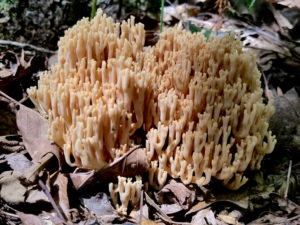
Nitrogen fixation, which is performed by specialized microorganisms and plants, such as these Texas Bluebonnets, converts atmospheric nitrogen and soil minerals into nutrients that are essential to all life on earth.
Life on earth depends on the continuous cycling of about 30–40 of the 90 chemical elements that occur in nature. Native vegetation’s extensive root systems and associated microorganisms digest plant and animal waste and other dead organic matter, recycling nutrients back into the ecosystem. Plants and symbiotic bacteria and fungi also partner to make atmospheric nitrogen, mineral phosphorous and other essential nutrients available to plants and animals through nitrogen fixation and other processes. Native plant communities also improve soil health and increase soil organic carbon, infiltration rates, water holding capacity and fertility compared to row crops or introduced non-native species.

Fungi and other organisms recycle plant and animal waste to maintain soil fertility and support the food web. Photo by Eric Hunt, Arkansas Native Plant Society
Examples and Additional Resources
Factsheet on native plants and soil fertility From Natives First
Millennium Ecosystem Assessment on nutrient cycling services and human well being
Niger Native tree fixes N etc and restores soils — now threatened as monoculture vulnerable to disease? https://www.theguardian.com/world/2018/aug/16/regreening-niger-how-magical-gaos-transformed-land

